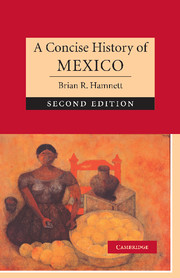Book contents
- Frontmatter
- Contents
- List of illustrations
- Chronology
- Preface to the second edition
- Preface to the first edition
- 1 Mexico in perspective
- 2 The pre-Columbian era
- 3 The European incursion, 1519–1620
- 4 New Spain, 1620–1770: Spanish colonialism and American society
- 5 Destabilisation and fragmentation, 1770–1867
- 6 Reconstruction, 1867–1940
- 7 The monopoly party, 1940–2000
- 8 The Fox administration, 2000–2006
- 9 Cultural developments since Independence
- Final comments
- Bibliography
- Index
- Titles in the series
7 - The monopoly party, 1940–2000
Published online by Cambridge University Press: 05 June 2014
- Frontmatter
- Contents
- List of illustrations
- Chronology
- Preface to the second edition
- Preface to the first edition
- 1 Mexico in perspective
- 2 The pre-Columbian era
- 3 The European incursion, 1519–1620
- 4 New Spain, 1620–1770: Spanish colonialism and American society
- 5 Destabilisation and fragmentation, 1770–1867
- 6 Reconstruction, 1867–1940
- 7 The monopoly party, 1940–2000
- 8 The Fox administration, 2000–2006
- 9 Cultural developments since Independence
- Final comments
- Bibliography
- Index
- Titles in the series
Summary
The combination of favourable international circumstances and internal conditions enabled the governing party to become a monopoly party of government during the three decades after 1940. Mexican economic advances between 1940 and 1970 created a climate of optimism both at home and abroad. Lack of serious opposition after 1943, whether from right or left, provided the party with the opportunity to expand its control throughout most sectors of society. During the 1940s, business was gradually won over, as the leftist stance of the Cárdenas years was discarded and the old rhetoric dropped except for ceremonial occasions. The country's transformation from predominantly rural to urban, the expansion of national industries, the emergence of a mixed economy with a high state profile, the expansion of educational institutions all fostered the impression that Mexico had finally emerged from the blight of underdevelopment and was on the road to peace and prosperity.
The financial reform of 1954 opened the period known as ‘stabilised development’, generally associated with the Presidencies of Adolfo Ruiz Cortines (1952–58) and Adolfo López Mateos (1958–64) and Antonio Ortiz Mena's period as Minister of Finance (1958–70). Substantially this lasted until the recession of 1971, although structural problems had already appeared in the economy from the early 1960s. The generation that experienced those decades became accustomed to the combination of political stability, a modicum of social justice, and a growing economy.
- Type
- Chapter
- Information
- A Concise History of Mexico , pp. 240 - 291Publisher: Cambridge University PressPrint publication year: 2006

